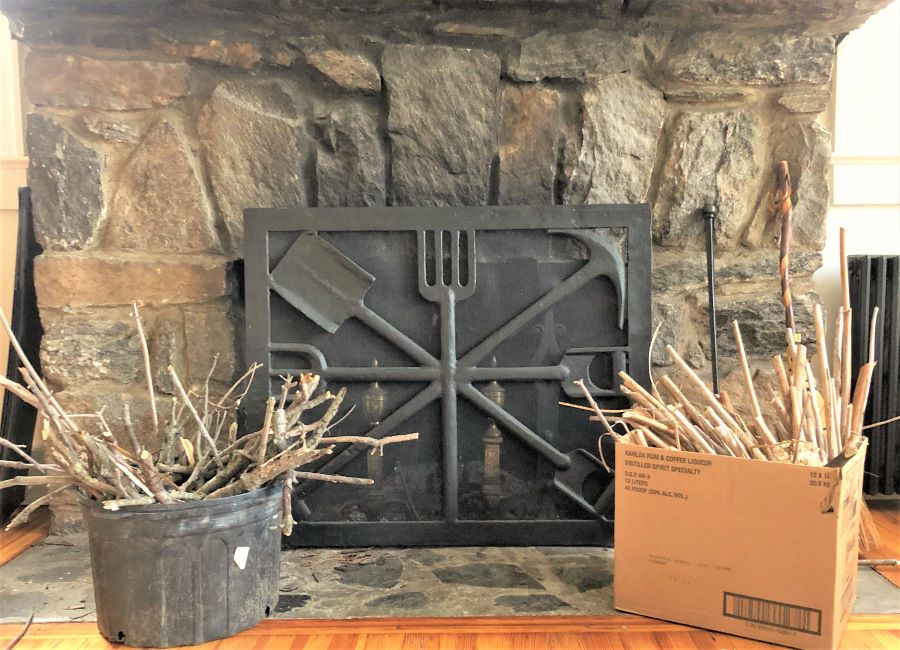AROUND THE GARDEN
A Stick in Time
By Chris Cohan
The solitary task of picking up sticks is more than just a chore, it is reflective. You can easily get lost in the regularity of the effort. The up–and–down rhythm of cleaning the yard and garden beds of fallen branches is satisfying. Followed by breaking them into similar length for burning in fireplace. Celebrate the end of winter with a final wood fire. The smell is soothing, especially as you gathered the wood yourself.
It’s time to get outside. No more Netflix, reruns of “The Office” or “Family Guy”. The air is fresh. Daffodils and wood hyacinths are up. Bright yellow forsythia brings a smile to all winter– weary faces. The dormant mysteries of your garden unfold daily before your eyes. It’s happening, spring is here!
The City suspended green waste pickup. So, it’s FINALLY time to start a compost pile. Think of all those leaves, coffee grounds, veggies, and fruit scraps just decomposing into the best soil you could ever have.
Don’t be deterred by Mona Corona. There is so much to do in your garden. Here are a top few chores to get you and your garden going:
- Prune all roses bushes byhalf. Cultivate 1 tablespoon of Epsom salts around bases.
- Cut those butterfly bushes way back by a minimumof two-thirds. If not, they become top–heavy and topple.
- Red and yellow twig dogwood deliver awesome winter color on new wood. They should be drastically cut to within 1 foot ofthe ground. They are rapid growers; the new wood will be rich in color providing winter delight.
- Catmint, daylilies andhostas are covered in their protective winter coat of last year’s foliage. It can easily be removed by hand.
- Mulch all plants and beds.
- Start fertilizing by using up the leftover bag biding its time in the back of your garage. If you’re buying a fresh supply, organic,slow-releaseis the way to go.
- Spray plants with a dormant oil spray like NEEM. It’snatural and kills lots of overwintering insects.
- Early season weeding is easiest and deliver best results. Follow with mulch to keep future weeds down, moisture in,and speed up organic decomposition delivering much needed nutrients to your plants.
- As daffodils, hyacinths, and tulips fade, clip off their flower stalks. This encourages the plants to store energy in their bulbs instead of setting seed. Just be sure to leave the foliage alone until it fades naturally. The plant needs the leaves to make energy for next year’s flowers.
- Add songbird houses for bluebirds, wrens, purple martens, and chickadees. Nesting songbirds will devour pesky insects that would otherwise feast on you or your garden. Select birdhouses designed with the appropriately sized entrance holesfor the variety you want to attract. Avoid birdhouses with perches; birds don’t use them, but predators do. Make sure to mount birdhouse at the correct height and location.
- Nowis the time for gardeners to prepare their soil for cool-season vegetables like potatoes, onions, broccoli, beets, spinach,and kale. Cool-season crops mean those that can be planted in the spring before the last frost, and as soon as the soil is prepared.
- Divide and spread out perennials as needed.
April brings hope to the garden, but also frustration. You may wish that you could garden in short sleeves whenever you feel like it, but that’s probably not happening. Accept the fact that not every day is going to bring pleasant weather, bundle up as needed, and get your gardening work in. That way, when temperatures suddenly skyrocket, you can go to the beach instead of working in the garden.
Be positive, stay healthy, get some fresh air, sunshine, and exercise around your property. You will feel better completing chores in the face of so much uncertainty.















